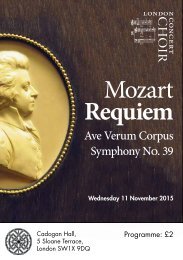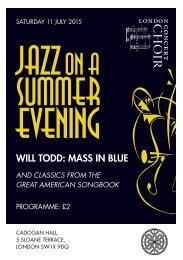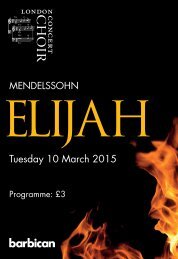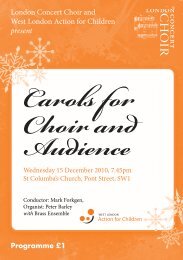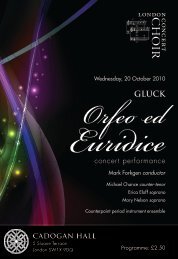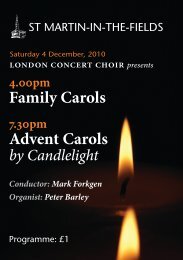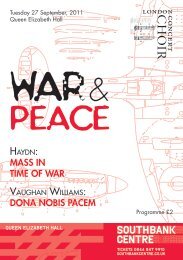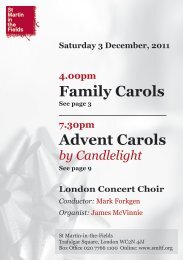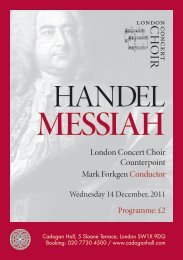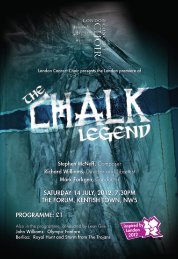11 May 2013: Music for the Coronation of Her Majesty Queen Elizabeth II
You also want an ePaper? Increase the reach of your titles
YUMPU automatically turns print PDFs into web optimized ePapers that Google loves.
The <strong>Coronation</strong><br />
The coronation <strong>of</strong> <strong>Queen</strong> <strong>Elizabeth</strong> <strong>II</strong> on 2 June 1953 was one <strong>of</strong> <strong>the</strong> defining events<br />
<strong>of</strong> <strong>the</strong> decade following <strong>the</strong> end <strong>of</strong> <strong>the</strong> Second World War. The young <strong>Queen</strong> was<br />
aged just 27 and her coronation brought colour, pomp and pageantry to a nation<br />
still suffering <strong>the</strong> effects <strong>of</strong> wartime austerity.<br />
The ceremony took place in Westminster Abbey, which has been <strong>the</strong> coronation<br />
church since 1066. The Abbey was closed to <strong>the</strong> public <strong>for</strong> six months while extensive<br />
preparations were carried out, not <strong>the</strong> least <strong>of</strong> which was to provide enough seating<br />
<strong>for</strong> <strong>the</strong> more than 8,000 guests (four times <strong>the</strong> Abbey’s usual capacity).<br />
<strong>Coronation</strong>s have always been celebrated in <strong>the</strong> context <strong>of</strong> <strong>the</strong> Mass or Holy<br />
Communion. The liturgy is complex and <strong>the</strong>re have been many changes over <strong>the</strong><br />
centuries, but certain key elements have always been present. The most notable <strong>of</strong><br />
<strong>the</strong>se are: <strong>the</strong> <strong>for</strong>mal procession into <strong>the</strong> Abbey; <strong>the</strong> recognition <strong>of</strong> <strong>the</strong> Sovereign<br />
by <strong>the</strong> people; <strong>the</strong> taking <strong>of</strong> an oath; <strong>the</strong> solemn anointing with holy oil; <strong>the</strong><br />
investiture with regalia, culminating in <strong>the</strong> crowning; <strong>the</strong> enthronement (at which<br />
point <strong>the</strong> Sovereign symbolically ‘takes possession’ <strong>of</strong> <strong>the</strong> kingdom), and <strong>the</strong><br />
receiving <strong>of</strong> homage.<br />
<strong>Music</strong> has always played an important role in coronations and <strong>for</strong> <strong>the</strong> <strong>Queen</strong>’s<br />
coronation in 1953 <strong>the</strong> Organist and Master <strong>of</strong> <strong>the</strong> Choristers <strong>of</strong> Westminster<br />
Abbey, William McKie, was appointed director <strong>of</strong> music. The choirs <strong>of</strong> <strong>the</strong><br />
Abbey and <strong>the</strong> Chapel Royal were augmented by singers from most <strong>of</strong> <strong>the</strong> major<br />
ca<strong>the</strong>drals and choral foundations in <strong>the</strong> country to create a choir <strong>of</strong> some 400<br />
voices accompanied by a specially selected orchestra <strong>of</strong> 60 players. The nature<br />
<strong>of</strong> <strong>the</strong> seating arrangements in <strong>the</strong> Abbey made it impossible <strong>for</strong> everyone to see<br />
<strong>the</strong> conductor and two assistant conductors helped to convey McKie’s beat to <strong>the</strong><br />
per<strong>for</strong>mers.<br />
Some <strong>of</strong> <strong>the</strong> music sung in 1953 had been per<strong>for</strong>med at previous coronations,<br />
most notably Parry’s fine setting <strong>of</strong> I was glad which had been written originally <strong>for</strong><br />
Edward V<strong>II</strong>’s coronation in 1902, and Handel’s Zadok <strong>the</strong> Priest which has been<br />
per<strong>for</strong>med at every coronation since that <strong>of</strong> George <strong>II</strong> in 1727. But <strong>the</strong>re was<br />
much new music too, including a Te Deum and <strong>the</strong> march Orb and Sceptre from<br />
William Walton, and <strong>the</strong> motet O taste and see from Vaughan Williams. The latter’s<br />
arrangement <strong>of</strong> <strong>the</strong> Old Hundredth, made at his own suggestion, was a remarkable<br />
musical innovation – <strong>the</strong> first congregational hymn ever to be sung at a coronation.<br />
Dr Tony Trowles<br />
Head <strong>of</strong> <strong>the</strong> Abbey Collection and Librarian, Westminster Abbey<br />
and member <strong>of</strong> London Concert Choir




